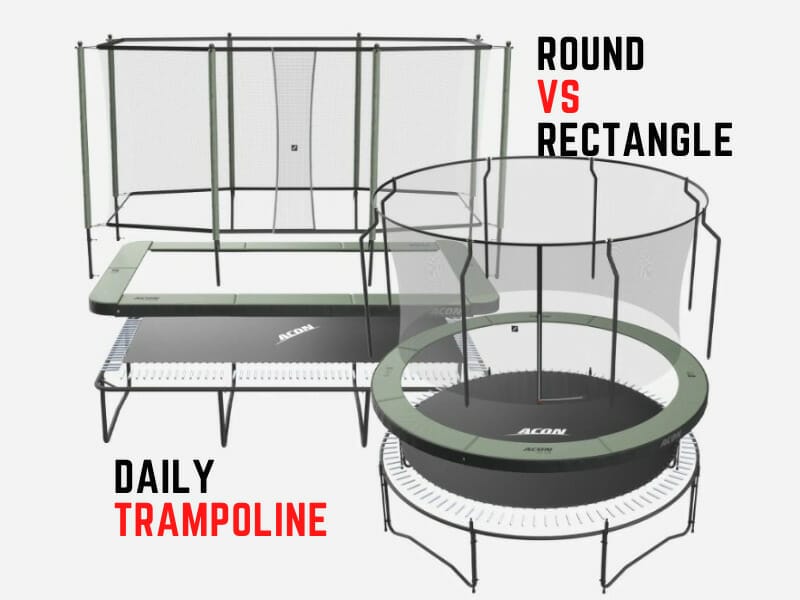Standard trampolines nowadays can be found in either a round or a rectangular design. However, it’s not simply their external look that sets them apart. With all the different sizes, shapes, materials, and prices available on the market right now, the Round vs Rectangle trampoline can be overwhelming.
Don’t worry! In this blog post, we’ll break down everything you need to consider before buying a trampoline – frame strength & safety concerns, weight limitations suitable for everyone in your family, and pricing options that won’t stretch your wallet too thin. So look no further if you want quick answers when choosing a reliable round trampoline versus a rectangle trampoline.
Let’s look at the comparison of both trampolines in detail!
A Sneak Peek Into Round Vs Rectangle Trampoline
| Parameters | Round | Rectangle |
| Size | 6 FT, 8 FT, 10 FT, 12 FT, 14 FT, 15 FT and 16 FT | 7x10ft, 8x12ft, 9x14ft, 10x17ft and 14x16ft |
| Weight Limit | 200-400 pounds | 300-450 pounds |
| No. of Springs (Depending on Size) | 36-120 | 56-110 |
5 Differences You Should Know: Round vs Rectangular Trampoline
1. Frame Strength
The durability of the trampoline frame is essential. The material used to construct the trampoline’s framework should be the primary focus of your research instead of the trampoline’s design. Simple steel is used in the construction of certain trampolines. Rust is a common problem for these frames, and everyday usage may cause harm.
Galvanized Steel
Galvanized steel, unlike ordinary steel, is the better option for a sturdy structure. Because of its galvanization process, steel treated this way is far less likely to corrode. As an added bonus, the durability of this material likely implies a more extended guarantee for your trampoline.
The Protective Layer Provided by Steel Frame
Powder-coated steel frames are available on different trampolines. This protective layer will keep the frame from deteriorating and breaking down. Investing in a trampoline of higher quality will provide better returns in the long term.
Note: When deciding between a round and a rectangular trampoline, you should know which one has the stronger structure.
2. Safety
The safety of the trampoline is a top priority. In order to ensure your children are jumping in a safe environment, look for a trampoline with a strong enough frame and good-quality netting.
You also might be interested in: How to Attach Net to Trampoline
Round Trampoline
Round trampolines are often considered to be safer than rectangular ones due to the fact that they tend to provide a softer landing since the jumper is distributed evenly across the entire surface. Additionally, their round shape prevents the jumper from bouncing off in a strange or unexpected direction.
Rectangle Trampoline
On the other hand, rectangular trampolines offer more room to jump and are often more suited for tricks than a round trampoline would be. However, since the springs are located only in the middle of the trampoline, the landing is not as soft or even, and the jumper may land in an awkward position.
3. Round Vs Rectangle Trampoline Weight Limit
You also need to think about the weight limits. Is the trampoline going to be used by several kids at once? Will adults use the trampoline? You should only buy a trampoline if it can support the weight you want to put on it.
The size and configuration of a trampoline determine the maximum allowable load. The following are the recommended maximum user weights for many typical diameters of round trampolines.
- Trampolines usually have a weight limit of 200–250 pounds, which is true for most standard-sized, Round trampolines (8′ or 10′ in diameter).
- The normal weight limit for a 12-foot-diameter trampoline is 250 to 300 pounds.
- However, you can usually bounce between 250 and 400 pounds on a circular/round trampoline 14 or 16 feet in diameter.
Many rectangular trampolines have a weight limit of 300 to 450 pounds, no matter how big or little.
Due to the configuration of the springs, rectangular trampolines can support greater mass. Because of the rectangle’s form, only a fraction of the springs is engaged with each leap. As a result, you’ll be able to carry more weight with less effort. When jumping on a round trampoline, the weight is distributed more evenly over the springs.
4. Bounce Quality
This will likely be the most appealing quality to children. However, size does affect how well something bounces. Smaller trampolines naturally have less bounce. Those with little children may want to get a smaller one that won’t take them too far.
You also might be interested in: Why Is My New Trampoline Not Bouncy?
When comparing trampolines of different shapes, it is clear that the rectangular variety has more rebounding potential than its round counterpart. It is safe to assume that your jump will be the same height and intensity on a rectangle trampoline regardless of where you land.
The reason behind this is because while jumping on a rectangular trampoline, only a portion of the springs is really engaged. Instead, each part of the trampoline has its own set of springs that act independently.
5. Price
Your budget is one of the most important factors when looking for a trampoline.
- The average cost of a Round Trampoline is around $300 – $350.
- A Rectangular Trampoline costs around $500 – $550.
The following variables might change the cost of a trampoline:
Material
The cost of a trampoline might vary depending on the kind of material used to construct the mat. Woven nylon and polyethene are common examples of such materials.
Size
The price of a trampoline increases as its size increases. However, there is no difference between round and rectangular shapes in this regard.
Shape
Depending on demand and supply, the price of a trampoline may vary greatly depending on its form, with round models often being the most economical.
Age
Trampolines are available, both new and pre-owned. New trampolines are more expensive than old ones, but they last far longer and are more cost-effective in the long run.
For details you can check out the following video:
Conclusion
There are a number of things to consider when buying a trampoline. Size, shape, and weight limit should include all factors in your decision. It is also essential to consider what material the trampoline is made of and how much it will cost. These considerations will help you make an educated decision when purchasing a trampoline.
Round or rectangle, which trampoline did you like the most? Let us know in the comments section.




1 thought on “Round Vs Rectangle Trampoline: Which is Really Better?”